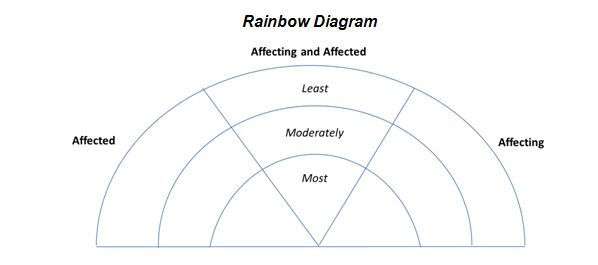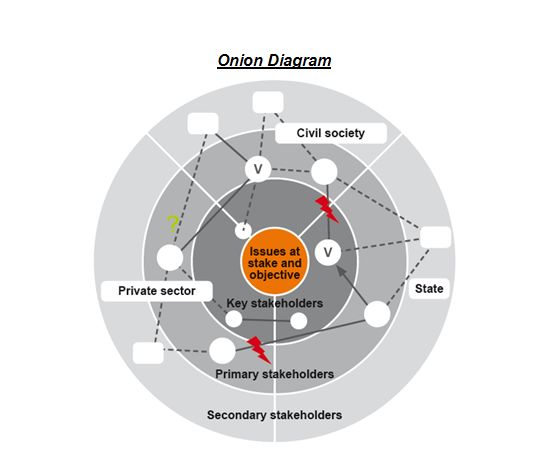Rainbow and onion diagrams are another tool for visualizing stakeholders and identifying potential allies, targets and detractors.
Practical Instructions for Rainbow Diagrams
Place cards representing the stakeholders most affected by the issue, or who have the strongest influence on it, on the inner segments. Cards representing those who are the least affected, or have the least influence, are placed on the outer segments.
For a more detailed analysis, you can use differently colored cards for different types of stakeholders, or vary the size of the cards. Relations between stakeholders can be visualized with lines, which can be varied (e.g. straight, dotted, jagged) according to the type of relation.

The diagram can be adapted by using other characteristics (instead of “affecting” and “affected”) that describe key differences between stakeholders. For example, you can transform the rainbow diagram into a spectrum-of-actors exercise by splitting the diagram in five sections for ‘active allies’, ‘allies’, ‘neutral parties’, ‘opponents’ and ‘active opponents’. This can be a useful exercise to inform your choice of tactics within the broader campaign strategy.
For a step-by-step-guide on stakeholder analysis using rainbow diagrams see Chevalier, J. ‘SAS2 1.0: Stakeholder Identification’ in Social Analysis Systems.
Onion diagrams use the same basic approach as rainbow diagrams, but draw a full circle to visualize relations between different actors.
In the example below (GTZ, 2009), key stakeholders with low influence on the issue at stake are depicted with small circles; those with high influence with larger circles. The letter V designates “veto players”, i.e. influential actors who can stop the campaign from reaching its goal. Rectangular cards are for secondary stakeholders. The solid lines between stakeholders symbolize strong relationships (double lines: institutionalized relationships), dotted lines more informal ones. Arrows show the direction of dominance; the red lightning symbol points out tension or conflict; crossed lines symbolize interrupted or damaged relationships.
